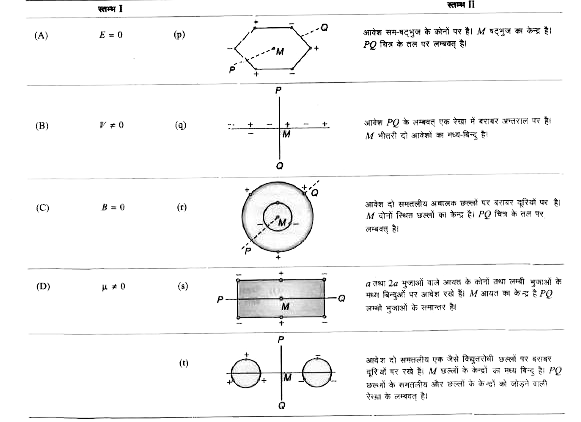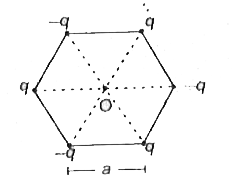Six point charges , each of the same magnitude q, are arranged in different manners as shown in Column II . In each case, a point M and a line PQ passing through M are shown . Let E be the electric field and V be the electric potential at M (potential at infinity is zero ) due to the given charge distribution when it is at rest . Now, the whole system is set into rotation with a constant angular velocity about the line PQ . Let B be the magnetic field at M and μ be the magnetic moment of the system in this condition . Assume each rotating charge to be equivalent to a steady current .

The correct Answer is:(##JA09_PHYP1E08001_A01##)
Step by step video, text & image solution for Six point charges , each of the same magnitude q, are arranged in different manners as shown in Column II . In each case, a point M and a line PQ passing through M are shown . Let E be the electric field and V be the electric potential at M (potential at infinity is zero ) due to the given charge distribution when it is at rest . Now, the whole system is set into rotation with a constant angular velocity about the line PQ . Let B be the magnetic field at M and mu be the magnetic moment of the system in this condition . Assume each rotating charge to be equivalent to a steady current . by Physics experts to help you in doubts & scoring excellent marks in Class 12 exams.
Updated on:21/07/2023Topper's Solved these Questions
- JEE ADVANCEDBOOK - JEE ADVANCED PREVIOUS YEARCHAPTER - JEE ADVANCEDEXERCISE - SECTION-I (Single correct Choice Type )
11 Videos
- JEE ADVANCEDBOOK - JEE ADVANCED PREVIOUS YEARCHAPTER - JEE ADVANCEDEXERCISE - SECTION-II (Multiple correct Choice Type )
5 Videos
- JEE ADVANCEDBOOK - JEE ADVANCED PREVIOUS YEARCHAPTER - JEE ADVANCEDEXERCISE - SECTION-III ( Comprehension Type )
6 Videos
- JEE (ADVANCE) 2020BOOK - JEE ADVANCED PREVIOUS YEARCHAPTER - JEE (ADVANCE) 2020EXERCISE - SECTION 3
6 Videos
- JEE ADVANCED 2020BOOK - JEE ADVANCED PREVIOUS YEARCHAPTER - JEE ADVANCED 2020EXERCISE - SECTION-3
6 Videos
Similar Questions
A piece of wire is bent in the shape of a parabola y=kx2 (y-axis vertical) with a bead of mass m on it. The bead can slide on the wire without friction. It stays at the lowest point of the parabola when the wire is at rest. The wire is now accelerated parallel to the x-axis with a constant acceleration a. The distance of the new equilibrium position of the bead, where the bead can stay at rest with respect to the wire, from the y-axis is:
View SolutionTwo metallic rings AandB, identical in shape and size but having different reistivities ρAandρB, are kept on top of two identical solenoids as shown in the figure . When current I is switched on in both the solenoids in identical manner, the rings AandB jump to heights hAandhB, repectively , with hA>hB . The possible relation(s) between their resistivities and their masses mAandmB is(are)

View SolutionScientists are working hard to develop nuclear fusion reactor Nuclei of heavy hydrogen, _(1)2H , known as deuteron and denoted by D, can be thought of as a candidate for fusion rector . The D−D reaction is _(1)2H+21H→12He+n+ energy. In the core of fusion reactor, a gas of heavy hydrogen of _(1)2H is fully ionized into deuteron nuclei and electrons. This collection of _12H nuclei and electrons is known as plasma . The nuclei move randomly in the reactor core and occasionally come close enough for nuclear fusion to take place. Usually , the temperature in the reactor core are too high and no material will can be used to confine the to plasma for a time t0 before the particles fly away from the core. If n is the density (number volume ) of deuterons , the productnt0is called Lawson number. In one of the criteria , a reactor is termed successful if Lawson number is greater then 5×1014s/cm2
it may be helpfull to use the following boltzmann constant
λ=8.6×10−5eV/k,e24πs0=1.44×10−9eVm
Assume that two deuteron nuclei in the core of fusion reactor at temperature energy T are moving toward each other, each with kinectic energy 1.5kT , when the seperation between them is large enough to neglect coulomb potential energy . Also neglate any interaction from other particle in the core . The minimum temperature T required for them to reach a separation of 4×10−15m is in the range
View SolutionA spherical bubbles inside water has radius R . Take the pressuere in the bubbled and the water pressure to be pv. The bubble now gets compressed radially in an adiabatic manner so that its raduis becomes (R - a) . For a<<R the magnitude of the work done in the process is given by (4πpoRa2)X. where X is a a constant and y=Cp/Cv=41/30. The value of X is
View SolutionPut a unifrom meter scale horizontally on your extended index fingers with the left one at 0.0 cm and the right one at 90.00 cm when you attempt to move both the fingers slowly towards the center , initially only the left finger slips with respect to to the scale and the right finger does not . after some distance, the left finger stops and the right one starts slipping . Then the right finger stops at a distance XR from the center (50.00 cm ) of the scale and the left one starts slopping again . This happens because to the difference in the fiictional forces on the two fingers . it the coefficients of static and dynamic between the fingers and the scale are 0.4 and 0.32 respectively , the value of XR (in cm is ...........
View Solutionएक ......... उन समस्त बिन्दुओं का समूह होता है जिन पर आवेश वितरण के कारण विद्युत् विभव एक-समान होता है।
View Solutiona भुजा वाले किसी गहन के प्रत्येक कोने (corner) पर qआवेश स्थित है । ऐसे आवेश वितरण के कारण घन के केंद्र पर विधुत-विभव तथा विधुत-क्षेत्र का परिमाण ज्ञात करें ।
View Solutionस्तम्भ II मे दर्शाए अनुसार 6 बिंदु आवेश, जिसमें से प्रत्येक का परिमाण q है भिन्न भिन्न प्रकार से नियोजित है। प्रत्येक में एक बिंदु M तथा M से जाने वाली एक रेखा PQ दिखाई गई है। मान लें कि जब आवेश स्थिर है तो दिए गए आवेश वितरण के कारण बिंदु M प उत्पन्न विद्युत क्षेत्र E और विद्युत विभव V है (अनन्त पर विभव को शून्य मानें) अब यह आवेश वितरण रेखा PQ के परितः एकसमान कोणीय वेग से घुमाया जाता है । इस स्थिति में बिंदु M पर उत्पन्न चुम्बकीय क्षेत्र B तथा चुम्बकीय आघूर्ण μ है। प्रत्येक घूमते आवेश को एक स्थिर धारा के बराबर मानें।

View SolutionElectric field vector in a region is given by E=(3hati+4hatj)V-m^(-1) . The potential at the origin is zero. Then, the potential at a point (2, 1) m is
View SolutionSix point charges are placed at the vertices of a regular hexagon of side a as shown. If E represents electric field and V represents electric potential at O then,

View SolutionFrom a point charge, there is a fixed point A. At a, there is an electric field of 500 V/m and potential difference of 3000 V. Distance between point charge and A will be
View Solutionएक बिंदु आवेश के कारण एक बिंदु पर विद्युत क्षेत्र 20 NC−1 है और उस बिंदु पर विद्युत विभव 10 JC−1 है। आवेश से बिंदु की दूरी और आवेश के परिमाण की गणना करें।
View SolutionThe electrical potential at a certain distance from a point charge is 600V the electric field is 200N//C . The distance of the point charge is….m.
View SolutionElectric field intensity at a point B due to a point charge Q kept at point A is 24NC−1, and electric potential at B due to the same charge is 12JC−1. Calculate the distance AB and magnitude of charge.
View SolutionElectric Potential Basics, Electric Potential due to a point charge, Potential due to cntinuous charge distribution, Ring, Spherical Shell
View Solution
